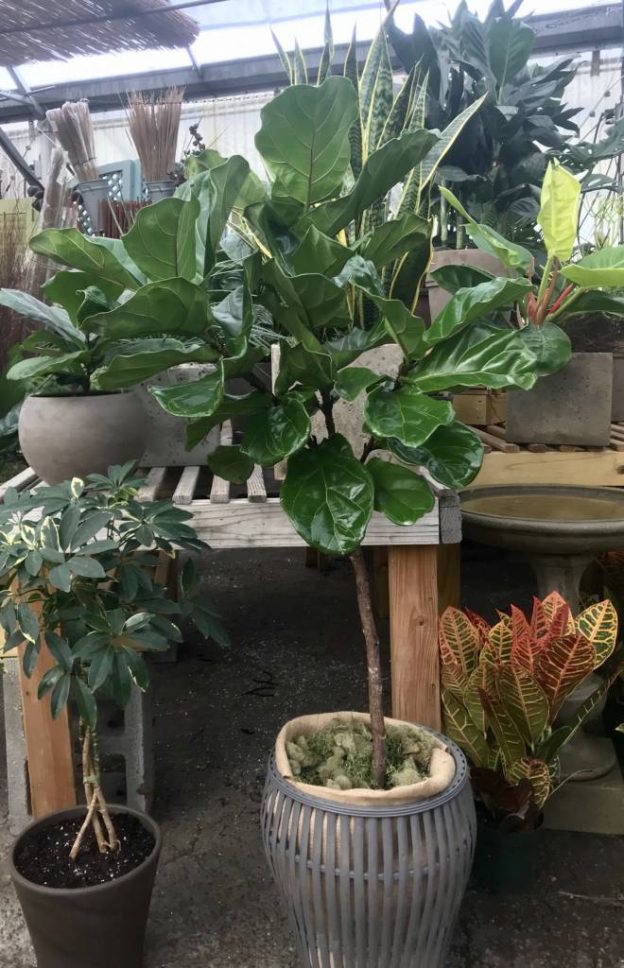The fiddleleaf fig is the latest houseplant wonder, used by interior designers and houseplant owners across the country. Its popularity is well deserved as it’s a striking, large leaved plant, often trained into a tree form and seen on the pages of magazines everywhere.
Maybe you’ve succumbed to the “Everyone has a fiddle leaf fig, I need one too.” pressure but now aren’t sure how to care for it? Well, first things first – It’s always smart to look at where a plant originated, then try your best to duplicate that in your home.
Ficus lyrata are native to western Africa, from Cameroon west to Sierra Leone, where it grows in lowland tropical rainforest. Their large leaves enable them to catch as much light as possible, and in this environment they can grow up to 100 feet in height.
Creating this environment in your home can be daunting. Light is the first challenge. Ficus lyrata will prefer an extremely bright room, but bear in mind too much direct sun may burn its leaves.
The ideal placement would be in a spot that is in very bright light most of the day. If there’s direct light through southern or western windows, don’t place your fiddleleaf fig directly in them but back it off so it receives the light but not the hot sun.
Fiddleleaf fig leaves are very big and they can be dust collectors. It’s important to keep these large leaves clean so they can absorb as much light as possible to aid in photosynthesis. To do this, carefully cradle each leaf in your palm and gently wipe them with either a damp sponge or a microfiber cloth. Do this at least once a month.
Water is the next consideration. In its native habitat, the fiddleleaf fig stays uniformly moist all the time. The trick is to keep it watered just enough, but not to let it stay too wet which can cause root rot and bacterial diseases. Root rot will manifest itself in older leaves developing brown spots, then dropping off, a very common problem with ficus lyrata in the home. Leaves typically remain dark green with one brown spot that gets larger and larger.
If you suspect this is the case, take your plant out of its pot and inspect the roots. If any are soft and mushy, root rot is the problem and is affecting the leaves and health of your plant. Remove the bad roots and repot with fresh potting soil. Groom the plant, removing any affected leaves.
Try to let your ficus go just dry. Push your finger into the soil 2”-3”. If it comes out dry, it’s time to water. When you water, water thoroughly, then let it go for however long it takes until your finger comes out dry again when you test the soil. Never let your plant sit in water.
If your fiddleleaf fig doesn’t receive enough water, it will be easy to tell as you’ll notice the edges of the leaves begin to turn brown, dry, and begin to curl. The overall look of the plant may appear wilted as well. Remove the brown leaves and try to be more aware of how much and how often you’re watering.
If the soil is coming away from the edge of the pot, that’s a sure sign you’ve not been watering enough. Check to see if your plant is near a heat vent that’s drying out the air and try misting your fiddleleaf fig to raise the humidity around it.
A serious problem, and another that also shows itself by brown spots on the leaves, is bacterial leaf spot. The difference between this and root rot is that bacterial disease affects all growth but especially attacks new leaves. You’ll notice small leaves and stunted growth, yellowing, and many brown spots on each leaf rather than one large brown area.
With bacterial leaf spot, the leaf will also turn yellow as the bacteria spreads. Eventually leaves will fall off. If less than 50% of the plant is affected, the best course of action is to remove all the diseased leaves and repot with new soil. Do not overwater as it’s recovering and place it in the maximum amount of light possible.
If your plant continues to decline or if more than half your plant has diseased leaves, it’s better to discard it and start over with a new plant.
Fertilize once a month through the growing season as they are very light feeders and let it rest through the winter. It also responds well to light pruning if necessary.
Finally, ficus lyrata prefer to be a bit potbound, but, if you see roots coming out the bottom of the pot and it needs to be moved up, repot using quality potting soil (We use Fafard.) into a pot no more than 2″ larger. The best time to repot is spring as your fiddleleaf fig is resuming more active growth.
Once you’ve found the right spot and have a handle on the proper care of your Ficus lyrata, you’ll find it to be a very durable and tough plant that should give you many years of enjoyment.
We offer Ficus lyrata at Oak Street Garden Shop when they are available. Please stop in and browse – you might find some other plants too!
~ We’re sorry, but we don’t offer online sales or ship plants at this time ~
If you follow us on Instagram or Facebook you’ve probably seen a new series of shop videos – if not, follow us and check them out! They’re also on our YouTube channel under Oak Street Garden Shop – if you’d like to see more, subscribe!

